50 years ago, Gordon E. Moore was keenly aware that "in an integrated circuit, the number of transistors will double every two years." Moore's law has always led the future of the entire semiconductor industry.
This article refers to the address: http://
Today, in the die space that Moore believes can hold thousands of transistors, it can already accommodate up to 2 billion transistors. After experiencing more than 50 years of exponential growth in chip technology, the industry is about to usher in another big change. With the advent of the Internet of Things era, we are expected to live in a world dominated by superconnections.
In the broad field of the Internet of Things, the Internet of Vehicles is one of the fastest growing segments. The impact of this groundbreaking change on automotive design has been particularly noticed by the Chinese market.
Connected cars all the way east
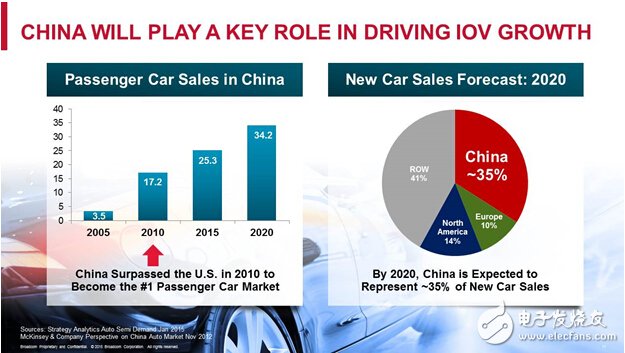
The core idea of ​​connected cars is to use semiconductor chips to achieve connectivity. As technology continues to innovate, analysts predict that by 2020 the number of chips per vehicle will approach 1,000. Let's take a closer look at the various leading technologies that drive the development of the Internet of Vehicles.
Wi-Fi wireless connection
Car Wi-Fi is like a game changer. Analysts predict that by 2019, the number of in-vehicle applications supporting Wi-Fi will increase by eight times. Integrating 5G Wi-Fi technology with the latest wireless 802.11ac standard will enable drivers and passengers to synchronize and transmit content from mobile devices to the vehicle's infotainment system and rear-seat display via a smooth 5 GHz channel on.
Automakers can take advantage of in-vehicle Wi-Fi to implement software upgrades and new features. Drivers can use their mobile devices to remotely view their vehicle location, fuel volume and mileage, as well as receive early warning information about vehicle performance and diagnostics on the same mobile device. In addition, the in-vehicle Wi-Fi technology can also set up a mobile hotspot to connect to the network without relying on cellular devices and moving. Wi-Fi is also expected to play a key role in V2X (vehicle-to-everything) communication and unmanned driving. The Wi-Fi advantage is even more pronounced as standards for supporting Gigabit and higher rates continue to evolve.
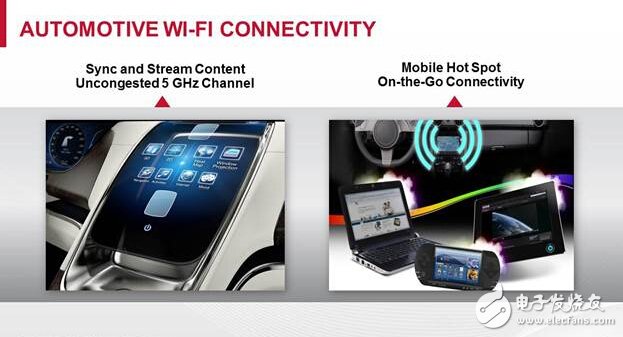
Based on the latest 802.11ac standard, 5G WiFi technology allows drivers and passengers to easily synchronize the content of mobile devices in the car and transmit them to the infotainment system and rear seat display of the vehicle.
Smart Bluetooth
For years, Bluetooth has become synonymous with car hands-free phones. Energy-saving technology called "smart Bluetooth" or "Low Energy Bluetooth" (BLE) is one of the important technologies for the development of Bluetooth in the car. With BLE, Bluetooth can work with very little power, and after a single charge, the battery can last for months or even years.
Smart watches, sphygmomanometers, pulse monitors, alcohol monitors, or blood glucose monitors will be the first wave of wearable devices that connect to the vehicle. Currently, Apple and Android systems have supported Bluetooth low energy (BLE) technology, and a low-power ecosystem has gradually taken shape. As Broadcom and other companies introduce semiconductor chips that support Bluetooth low-power (BLE) capabilities, the ecosystem will be extended to the automotive sector in the near future.
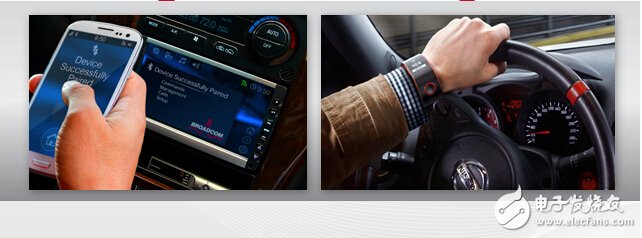
Bluetooth Smart Ready technology will play a vital role in the implementation of vehicle-to-wear technology connectivity, including the monitoring of biometrics such as fatigue driving, blood alcohol levels, and blood glucose levels.
Near Field Communication (NFC)
The development of Near Field Communication (NFC) technology related to mobile payments or contactless transactions has also been driven by the development of the automotive industry. By using NFC technology, the driver can pair the mobile device with the control panel with just a tap, eliminating the need to navigate through the menus on two separate screens.
In addition, the integration of NFC technology in the windshield allows NFC to support digital key exchange authentication, user profile and vehicle information exchange functions, which will greatly simplify the car rental process. NFC-enabled digital key applications can also be extended to other tasks, such as mobile payments and access to restricted buildings or parking lots.
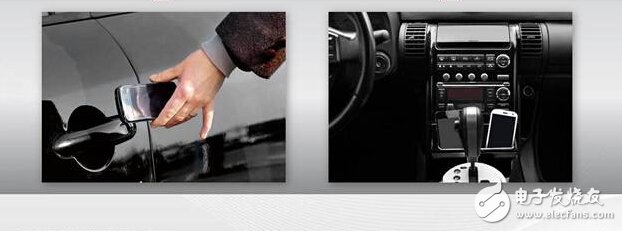
With NFC, the driver can connect the mobile device to the control panel by tapping. Wireless charging will become the standard configuration for vehicles, enabling a truly multi-device, ready-to-charge experience.
Wireless charging
Imagine charging a scene for multiple devices such as smartphones, tablets, and smart watches on a single platform like a central console without using multiple chargers and outlets. Wireless charging technology truly realizes a new "free-to-charge" experience and is compatible with a wide range of smart devices. Resonant wireless charging technology has a single-transmitter antenna design that supports multiple receivers and an integrated wireless power control system, and is capable of transmitting power over a non-metallic surface.
In the IoT world, users will have multiple Internet access devices, so the introduction of a single end-to-end wireless power solution is becoming imperative, and automakers have begun to incorporate this feature into future models. In the design plan.
Ethernet security
What is the most needed for vehicles equipped with networking and terminals? The answer is the network backbone. Ethernet has been the most popular and reliable network technology in the world for decades. Global Ethernet standards have long been successfully and securely deployed in dynamic, evolving environments (such as enterprise networks). Based on the characteristics of high bandwidth, cost performance, universality and inherent network security, the application of automotive Ethernet is increasing.
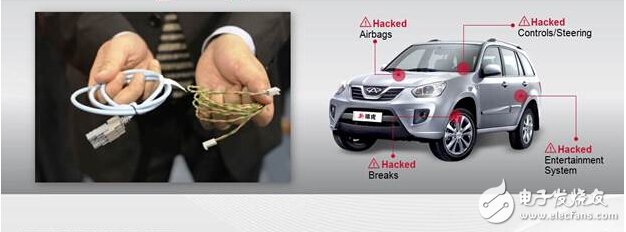
Car Ethernet is fully optimized for IoT applications, providing proven standards and maximum automotive network security.
Automotive Ethernet integrates professional, stand-alone systems into a centralized, secure platform. Multiple sites can access and exchange information simultaneously using a single data transfer protocol. From seamless connectivity to advanced driver-assisted features, Ethernet's cost-effectiveness delivers the safety and recreational features of luxury models into mid- to mid-eco models. These inherent characteristics are just one of many reasons why Ethernet can play a key role in the connected automotive industry in the future.
The road to the future
Constant innovation in the past 50 years has created a world that was almost unimaginable in 1965. Looking ahead, analysts predict that by 2025, all new cars will be “connectedâ€. With the evolution of transportation development prospects, the continuous accelerated development of technology will fully assist developers to fully meet the needs of drivers to experience real interconnection during the driving process.
Function description
The socket is ordinary converter,with two output 5V2A power USB power supply at the same time,can be very convenient in use electrical appliances and recharge the equipment at the same time,such as digital products like Iphone Ipad,MP3,MP4 etc.The charge apply to full range of international AC output,no-load power consumption less than 0.3W,with short circuit,overload,over-voltage protection,can be convenient for your life and save more energy
Timer Control Time Adgustment
1.Press the power switch 1 time,the 1HOUR LED will light on.The Timer into ON mode,USB and control socket output ON .
2.Continuously press the power switch the LED light on,the Countdown mode and LED light on will cycle change from 1HR,2HR,4HR,6HR,8HR,10HR.
3.Choose you need countdown time mode,the mode LED will lighto on,start countdown until countdown time finish,the control output and USB change to OFF
4.Then the countdown is start,The Time indicate LED will from high to low auto change until Countdown finish off.
Failure analysis:
1.check whether the power supply connection is good
2.check whether the USB cable is loosen
Warning Note:
1.Use indoor and dry location ONLY
2.The load max does not exceed 15A 3600W
3.This product does not convert voltage please do not miss use DO NOT exceed the maximum loading of 3600 Watts 15A
4.Always have earth connection for safety reason
5.If in doubt please consult with a qualified electrician
USB charger socket, USB socket, USB plug, USB plug socket
NINGBO COWELL ELECTRONICS & TECHNOLOGY CO., LTD , https://www.cowellsocket.com